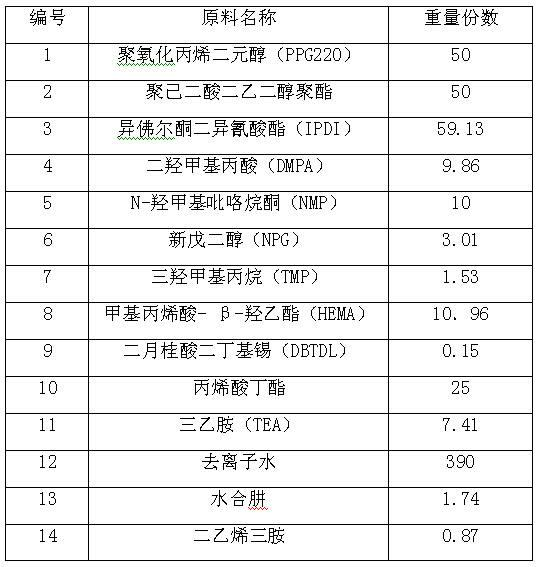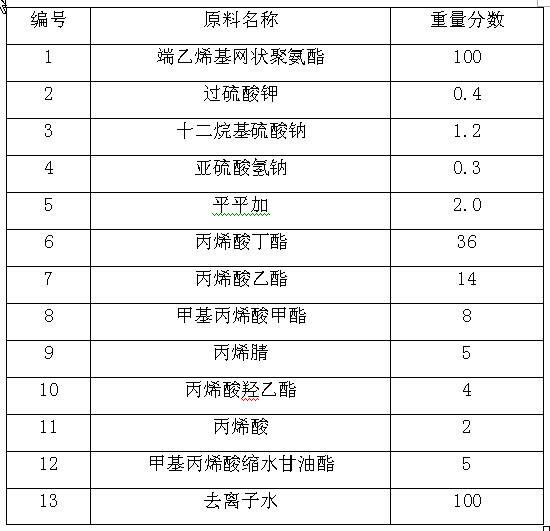Waterborne polyurethane-acrylate emulsion prepared by seed emulsion polymerization method
An emulsion polymerization, water-based polyurethane technology, applied in applications, inks, household appliances, etc., can solve problems such as adverse environmental effects, and achieve the effects of no formaldehyde release, fine particle size, excellent water resistance and friction resistance.
- Summary
- Abstract
- Description
- Claims
- Application Information
AI Technical Summary
Problems solved by technology
Method used
Image
Examples
example 1
[0032] Example 1: (PUA-1) The specific method for preparing polyurethane-acrylate emulsion by seed emulsion polymerization is as follows: 1) Preparation of aqueous dispersion of vinyl-terminated network polyurethane
[0033] Put PPG (molecular weight 2000) into a three-necked flask, vacuum dehydrate at 100°C for 2h; cool down to 80°C, add chain extender NPG and TMP, IPDI, keep warm at 85°C for 3h; cool down to 75°C, add hydrophilic monomer DMPA, 80°C heat preservation reaction for 2h; cool down to 65°C, add functional acrylate monomer HEMA and catalyst DBTDL, heat heat reaction for 1.5h. Cool down to 40°C, add mixed butyl acrylate to reduce viscosity, add neutralizer TEA, stir for 5 minutes, add deionized water to disperse into emulsion under high-speed stirring, slowly add hydrazine hydrate, diethylenetriamine and deionized water after 10-15 minutes The mixture was chain-extended and aged at 50°C for 1 hour to obtain vinyl-terminated reticular polyurethane.
[0034]
[0...
example 2
[0038] Example 2: (PUA-2)
[0039] 1) Preparation of vinyl-terminated network polyurethane aqueous dispersion
[0040] Put polytetrahydrofuran ether diol (molecular weight: 2000) into a three-necked flask, dehydrate in vacuum at 100°C for 2h; cool down to 80°C, add chain extender NPG and TMP, IPDI, and keep warm at 85°C for 3h; cool down to 75°C, add pro The water monomer DMPA was kept at 80°C for 2 hours; the temperature was lowered to 65°C, the functional acrylate monomer HEMA and the catalyst DBTDL were added, and the reaction was held for 1.5 hours. Cool down to 40°C, add mixed butyl acrylate to reduce viscosity, add neutralizer TEA, stir for 5 minutes, add deionized water to disperse into emulsion under high-speed stirring, slowly add hydrazine hydrate, diethylenetriamine and deionized water after 10-15 minutes The mixture was chain-extended and aged at 50°C for 1 hour to obtain vinyl-terminated reticular polyurethane.
[0041]
[0042] 2) Preparation of polyuretha...
example 3
[0045] Example 3: (PUA-3)
[0046] 1) Preparation of vinyl-terminated network polyurethane aqueous dispersion
[0047] Put polyethylene adipate diethylene glycol polyester (molecular weight 2000) into a three-necked flask, dehydrate in vacuum at 100°C for 2 hours; cool down to 80°C, add small molecule chain extenders NPG, TMP and IPDI, and keep warm at 85°C for reaction 3h; cool down to 75°C, add hydrophilic chain extender DMPA, keep warm at 80°C for 2h; cool down to 65°C, add functional acrylate monomer HEMA, catalyst DBTDL, keep warm for 1.5h; cool down to 40°C, add mixed butyl acrylate Ester monomer to reduce viscosity, add neutralizer TEA, stir for 5 minutes, add deionized water to disperse into emulsion under high speed stirring, slowly add hydrazine hydrate, diethylenetriamine and deionized water mixture for chain extension after 10-15 minutes, 50℃ After aging for 1 hour, a vinyl-terminated reticular polyurethane can be obtained.
[0048]
[0049] 2) Preparation o...
PUM
| Property | Measurement | Unit |
|---|---|---|
| Fineness | aaaaa | aaaaa |
Abstract
Description
Claims
Application Information
 Login to View More
Login to View More - R&D
- Intellectual Property
- Life Sciences
- Materials
- Tech Scout
- Unparalleled Data Quality
- Higher Quality Content
- 60% Fewer Hallucinations
Browse by: Latest US Patents, China's latest patents, Technical Efficacy Thesaurus, Application Domain, Technology Topic, Popular Technical Reports.
© 2025 PatSnap. All rights reserved.Legal|Privacy policy|Modern Slavery Act Transparency Statement|Sitemap|About US| Contact US: help@patsnap.com



